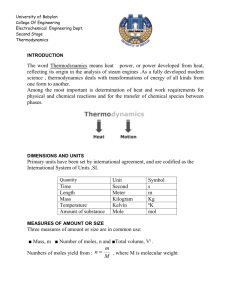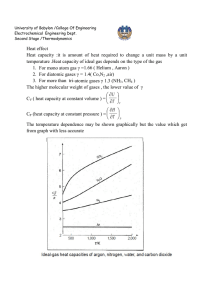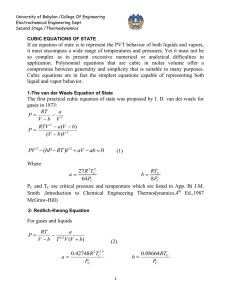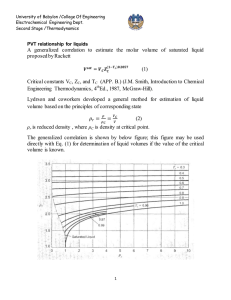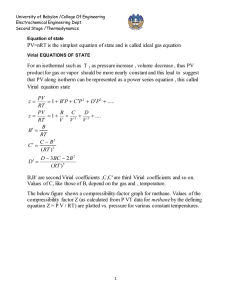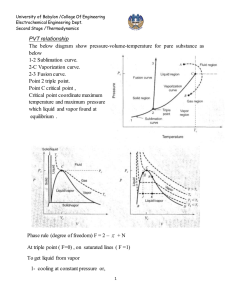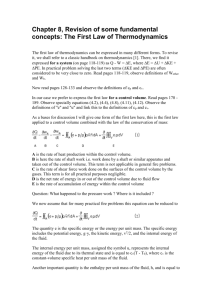Document 12919580
advertisement
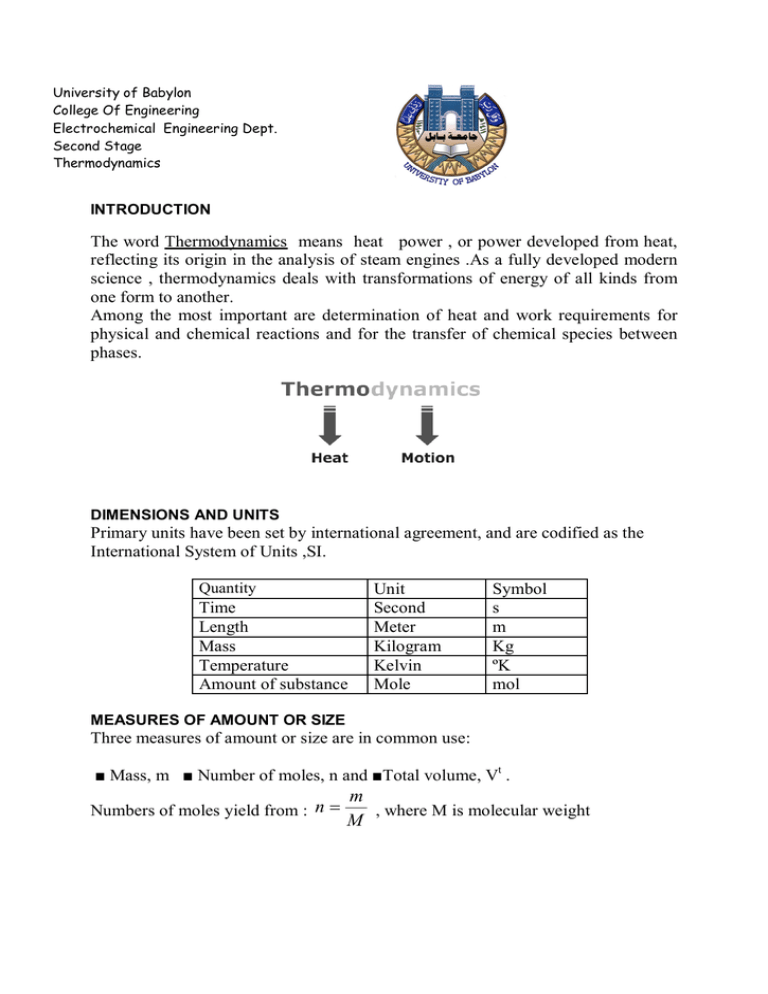
University of Babylon College Of Engineering Electrochemical Engineering Dept. Second Stage Thermodynamics INTRODUCTION The word Thermodynamics means heat power , or power developed from heat, reflecting its origin in the analysis of steam engines .As a fully developed modern science , thermodynamics deals with transformations of energy of all kinds from one form to another. Among the most important are determination of heat and work requirements for physical and chemical reactions and for the transfer of chemical species between phases. DIMENSIONS AND UNITS Primary units have been set by international agreement, and are codified as the International System of Units ,SI. Quantity Time Length Mass Temperature Amount of substance Unit Second Meter Kilogram Kelvin Mole Symbol s m Kg ºK mol MEASURES OF AMOUNT OR SIZE Three measures of amount or size are in common use: ■ Mass, m ■ Number of moles, n and ■Total volume, Vt . Numbers of moles yield from : n = m , where M is molecular weight M University of Babylon College Of Engineering Electrochemical Engineering Dept. Second Stage Thermodynamics Total volume, representing the size of a system, is a defined quantity given as the product of three lengths. It may be divided by the mass or number of moles of the system to yield specific or molar volume: Vt v Specific volume V = m Vt v Molar volume V = n Specific or molar density is defined as the reciprocal of specific or molar volume: p = V-1.These quantities (V and p) are independent of the size of a system, and are examples of intensive thermodynamic variables. They are functions of the temperature, pressure, and composition of a system, additional quantities that are independent of system size. Force The force unit is Newton , symbol ,N ,The Newton is defined as the force which when applied to a mass of 1 kg produces an acceleration of 1 m s -2 ; thus the Newton is a derived unit representing 1 kg m s-2 F=ma The kilogram force is equivalent to 9.806 65 N. ( 1 Newton = Kg .m . s-1) In the metric engineering system of units, force is treated as an additional independent dimension along with length, time, and mass. The kilogram force(kg f ) is defined as that force which accelerates 1 kilogram mass 9.806 65 meters per second per second . F = 1 ma gc where 1Kg f = 1 ´ 1Kg ´ 9.8m .s -1 gc And gc =9080665 Kg.m.Kg f -1s-2 University of Babylon College Of Engineering Electrochemical Engineering Dept. Second Stage Thermodynamics Weight properly refers to the force of gravity on a body, and is therefore correctly expressed in Newton’s or in kilograms force. Temperature Temperature is degree of hotness ,and it is commonly measured with liquid-inglass thermometers, wherein the liquid expands when heated. Thus a uniform tube, partially filled with mercury, alcohol, or some other fluid, can indicate degree of "hotness" simply by the length of the fluid column. However, numerical values are assigned to the various degrees of hotness by arbitrary definition. t oC = T o K - 273.15 t o F = T o R - 459.67 T o R = 1.8T o K University of Babylon College Of Engineering Electrochemical Engineering Dept. Second Stage Thermodynamics PRESSURE The pressure P exerted by a fluid on a surface is defined as the normal force exerted by the fluid per unit area of the surface. The unit used is called Pascal , symbol Pa (N.m-2) . In the metric engineering system a common unit is the kilogram force per square centimeter (kgf cm-2 ). The primary standard for pressure measurement is the dead-weight gauge in which a known force is balanced by a fluid pressure acting on a known area P = F mg = A A Where m is mass , g local acceleration , and A is the cross sectional area . Gauges in common use, such as Bourdon gauges, are calibrated by comparison with deadweight gauges. Since a vertical column of a given fluid under the influence of gravity exerts a pressure at its base in direct proportion to its height This is the basis for the use of manometers for pressure measurement. Conversion of height to force per unit area follows from Newton's law applied to the force of gravity acting on the mass of fluid in the column. The mass is given by: P = F mg Ah r g = = = r gh A A A The pressure to which a fluid height corresponds is determined by the density of the fluid (which depends on its identity and temperature) and the local acceleration of gravity. Thus the (torr) is the pressure equivalent of 1 millimeter of mercury at 273.15 K (0°C) in a standard gravitational field, and is equal to 133.322 Pa. Another unit of pressure is the standard atmosphere (atm), the approximate average pressure exerted by the earth's atmosphere at sea level, defined as 101 325 Pa, 101.325 kPa, or 0.101 325 MPa. The bar, an SI unit defined as l05 Pa, is equal to 0.986 923 atm. Most pressure gauges give readings which are the difference between the pressure of interest and the pressure of the surrounding atmosphere. These readings are known as gauge pressures, and can be converted to absolute pressures by addition of the barometric pressure. Absolute pressures must be used in thermodynamic calculations. University of Babylon College Of Engineering Electrochemical Engineering Dept. Second Stage Thermodynamics WORK Work W is performed whenever a force acts through a distance. By definition, the quantity of work is given by the equation: dW = Fdl where F is the component of force acting along the line of the displacement dl. The work which accompanies a change in volume of a fluid is often encountered in thermodynamics University of Babylon College Of Engineering Electrochemical Engineering Dept. Second Stage Thermodynamics dW = - pAd V A dW = - pdV since A is constant V2 dW = - ò PdV V1 The minus sign is required because the volume change is negative. The above equation expresses the work done by a finite compression or expansion process. Figure below shows a path for compression of a gas from point 1 with initial volume V1 at pressure P1 to point 2 with volume V2 at pressure P2. This path relates the pressure at any point of the process to the volume. The work required is given by equation and is proportional to the area under the curve of Fig. The SI unit of work is the newton-meter or joule, symbol J. In the metric engineering system the unit often used is the meter-kilogram force (m kgf). University of Babylon College Of Engineering Electrochemical Engineering Dept. Second Stage Thermodynamics ENERGY Kinetic Energy When a body of mass m, acted upon by a force F, is displaced a distance dl during differential interval of time dt, dW = madl By definition the acceleration is a= du/dt, where u is the velocity of the body. Thus dW = m dl du dl = m du = mudu dt dt u2 æ u 22 u12 ö æ mu 2 ö ÷÷ W = m ò udu = mçç - ÷÷ = Dçç 2 2 2 è ø è ø u1 Each of quantities ½ mu2 is a kinetic energy EK = 1 mu 2 2 Potential Energy If a body of mass m is raised from an initial elevation zl to a final elevation z2 , an upward force at least equal to the weight of the body must be exerted on it, and this force must move through the distance z2 - zl W = F ( z 2 - z1 ) = mg ( z 2 - z1 ) E P = mzg University of Babylon College Of Engineering Electrochemical Engineering Dept. Second Stage Thermodynamics Energy Conservation In any examination of physical processes, an attempt is made to find or to define quantities which remain constant regardless of the changes which occur. One such quantity, early recognized in the development of mechanics, is mass. The great utility of the law of conservation of mass suggests that further conservation principles could be of comparable value. Thus the development of the concept of energy logically led to the principle of its conservation in mechanical processes. If a body is given energy when it is elevated, then the body conserves or retains this energy until it performs the work of which it is capable. An elevated body, allowed to fall freely, gains in kinetic energy what it loses in potential energy so that its capacity for doing work remains unchanged. For a freely falling body this means that: DE K + DK p =0 mu 22 mu 12 + mz 2 g - mz 1 g = 0 2 2 The validity of this equation has been confirmed by countless experiments. Success in application to freely falling bodies led to the generalization of the principle of energy conservation to apply to all purely mechanical processes. Ample experimental evidence to justify this generalization was readily obtained. HEAT We know from experience that a hot object brought in contact with a cold object becomes cooler, whereas the cold object becomes warmer. Thus we say that heat Q always flows from a higher temperature to a lower one. That means the temperature deterrence is a driving force for transfer of energy as heat. When energy in the form of heat is added to a body, it is stored not as heat but as kinetic and potential energy of the atoms and molecules making up the body. The British thermal unit (Btu) quantity of heat which when transferred to one pound mass of water raised its temperature from ice-point or 32 °F to steampoint or 212 °F at standard atmospheric pressure . Likewise the calorie written as (cal) , was defined as quantity of heat which when transferred to one kilogram mass of water raised its temperature from 0 to 100°C at standard atmospheric pressure .
